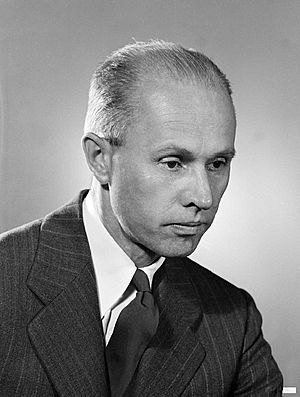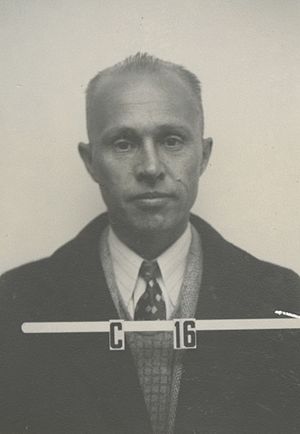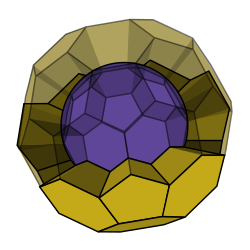George Kistiakowsky facts for kids
Quick facts for kids
George Kistiakowsky
|
|
|---|---|

George Kistiakowsky
|
|
| Born | December 1 [O.S. November 18] 1900 Boiarka, Russian Empire (now Ukraine)
|
| Died | December 7, 1982 (aged 82) Cambridge, Massachusetts, United States
|
| Nationality | Ukrainian-American |
| Citizenship | American |
| Alma mater | University of Berlin |
| Known for |
|
| Awards |
|
| Scientific career | |
| Fields | Physical chemistry |
| Institutions | |
| Doctoral advisor | Max Bodenstein |
| Doctoral students |
|
| Signature | |
 |
|
George Bogdanovich Kistiakowsky (born December 1, 1900 – died December 7, 1982) was a Ukrainian-American scientist. He was a professor of physical chemistry at Harvard University. He played a very important role in the Manhattan Project, which developed the first atomic bombs. Later, he became the Science Advisor to President Dwight D. Eisenhower.
Kistiakowsky was born in Boyarka, which was part of the Russian Empire (now Ukraine). His family was known for being educated and part of the intellectual community. He had to leave his home during the Russian Civil War. He went to Germany and earned his PhD in physical chemistry from the University of Berlin. In 1926, he moved to the United States. He joined Harvard University in 1930 and became an American citizen in 1933.
During World War II, Kistiakowsky led a section of the National Defense Research Committee (NDRC). This group worked on developing new explosives. He also directed the Explosives Research Laboratory (ERL). There, he helped create explosives like RDX and HMX. In 1943, he joined the Manhattan Project. He was put in charge of X Division. This team developed special "explosive lenses" needed for the implosion-type nuclear weapon. In July 1945, he saw the first atomic bomb explosion, known as the Trinity test. A few weeks later, an implosion-type bomb called "Fat Man" was dropped on Nagasaki.
After his government service, Kistiakowsky became active in anti-war efforts. He protested against the Vietnam War. He joined the Council for a Livable World, an organization that worked against nuclear weapons. He became its chairman in 1977.
Early Life and Education
George Bogdanovich Kistiakowsky was born in Boyarka, in the Kyiv Governorate of the Russian Empire. This was on December 1, 1900. His grandfather was a law professor. His father, Bogdan Kistiakovsky, taught legal philosophy. He was also a member of the National Academy of Sciences of Ukraine. George had a brother, Alexander, who became an expert on birds.
George went to private schools in Kyiv and Moscow. This was until the Russian Revolution began in 1917. He then joined the White Army, which fought against the Communists. In 1920, he escaped Russia on a French ship. After staying in Turkey and Yugoslavia, he went to Germany. He started studying at the University of Berlin that same year.
In 1925, he earned his PhD in physical chemistry. His professor was Max Bodenstein. George wrote his thesis on how light breaks down certain chemicals. He then worked as Bodenstein's assistant. His first published scientific papers were based on his thesis.
In 1926, Kistiakowsky came to the United States. He received a special fellowship to study at Princeton University. In 1926, he married Hildegard Moebius. They had a daughter, Vera, in 1928. Vera later became the first woman physics professor at MIT. George became an associate professor at Princeton in 1928.
In 1930, Kistiakowsky joined Harvard University. He stayed there for most of his career. At Harvard, he studied thermodynamics (how heat relates to other forms of energy), spectroscopy (how light interacts with matter), and chemical kinetics (the speed of chemical reactions). He also started working as a consultant for the government and businesses. He became an American citizen in 1933. In 1938, he became a full professor. He was elected to the United States National Academy of Sciences in 1939.
World War II Contributions
Developing New Explosives
Before the United States joined World War II, President Franklin D. Roosevelt created the National Defense Research Committee (NDRC) in 1940. This committee was formed to use science for defense. James B. Conant, the president of Harvard, led the division for bombs and chemicals. He asked Kistiakowsky to lead the section on explosives.
Kistiakowsky was concerned about America's knowledge of explosives. So, Conant set up the Explosives Research Laboratory (ERL) in Pennsylvania in 1940. Kistiakowsky became its technical director in 1941. The ERL grew quickly, from 5 staff members to 162 by 1945.
A key project was developing RDX. This was a powerful explosive created by the Germans. The challenge was to find a way to make it in large amounts. RDX was also mixed with TNT to make "Composition B." This was used in many weapons. Another mix was "torpex," used in torpedoes. Large-scale production of RDX began in 1943.
Kistiakowsky also helped create a special explosive called "Aunt Jemima." This was HMX, a non-toxic explosive, mixed with flour. It looked like regular flour and could even be used for cooking. This made it easy for Chinese guerrillas to smuggle it past Japanese checkpoints.
The ERL also studied how explosions work, including detonations and shock waves. Kistiakowsky visited England to meet with British experts. He studied the Chapman–Jouguet model, which describes how a shock wave from an explosion spreads. He realized that the speed of chemical reactions affected how explosions behaved. His team also worked on shaped charges, which focus the force of an explosion.
The Manhattan Project
At the Manhattan Project's Los Alamos Laboratory, scientists were trying to create a nuclear weapon. They were working on a method called implosion. This involves squeezing nuclear material to make it explode. However, early efforts were not very successful.
In 1943, the lab's director, Robert Oppenheimer, asked John von Neumann to look at the implosion work. Von Neumann suggested using high explosives in shaped charges to squeeze a sphere of nuclear material. This method could make the bomb work faster and use less material. Oppenheimer and other scientists were impressed. They realized they needed an expert in explosives. Kistiakowsky was the perfect choice. He joined the project as a consultant in October 1943.
Kistiakowsky was at first unsure about joining. He thought the bomb might not be ready in time to help win the war. But at Los Alamos, he began to reorganize the implosion effort. He used techniques like photography and X-rays to study how shaped charges behaved. He also brought his knowledge of explosives like Composition B.
In February 1944, Kistiakowsky replaced Seth Neddermeyer as the head of E (for explosives) Division. The implosion program became even more urgent. Scientists found that plutonium from nuclear reactors contained plutonium-240. This made it unsuitable for the simpler "gun-type" bomb. Implosion was the only way to make a plutonium weapon work.
In August, Oppenheimer reorganized the lab to focus on implosion. A new group, X Division, was created under Kistiakowsky. This team was tasked with developing the complex explosive lenses. These lenses used two types of explosives that detonated at different speeds. This created the perfect shock wave to compress the plutonium. Kistiakowsky chose Baratol for the slow explosive and Composition B for the fast one.
The lenses had to be perfect. New ways to mold the explosives were developed. In March 1945, Kistiakowsky joined the "Cowpuncher Committee." This group pushed the implosion effort forward. On July 16, 1945, Kistiakowsky watched the first atomic device explode in the Trinity test. A few weeks later, an implosion-type nuclear weapon, the "Fat Man," was dropped on Nagasaki.
During his time at Los Alamos, Kistiakowsky also helped the community. He used explosives to clear trees for a ski slope. This led to the creation of the Sawyer's Hill Ski Tow Association. He divorced his first wife in 1942 and married Irma E. Shuler in 1945. They divorced in 1962, and he then married Elaine Mahoney.
White House Service
In 1957, during President Eisenhower's time, Kistiakowsky joined the President's Science Advisory Committee. He became its chairman in 1959. He also led the Office of Science and Technology Policy from 1959 to 1961.

In 1958, Kistiakowsky told President Eisenhower that just inspecting foreign military sites was not enough to control nuclear weapons. He pointed out how hard it was to monitor missile submarines. He suggested focusing on getting rid of weapons instead of just inspections. In 1960, he proposed the "threshold concept" for arms control. This idea suggested banning all nuclear tests above a certain detection level. Then, the US and USSR would work together to improve detection technology. This would allow them to lower the allowed test yield over time.
President Eisenhower was concerned about the US nuclear war plans. Different military branches had their own plans, which led to confusion and wasted effort. In 1960, Eisenhower sent Kistiakowsky to evaluate the Strategic Air Command's war plans. Kistiakowsky's report showed that the plans were not coordinated. Many targets would be attacked multiple times, leading to "overkill." Eisenhower was shocked. This led to the creation of the Single Integrated Operational Plan (SIOP). This plan combined all nuclear operations into one single strategy.
Later Life and Activism
After his work with the Manhattan Project and the White House, Kistiakowsky continued to be a professor of physical chemistry at Harvard. He retired from Harvard in 1972.
He received many awards during his life. These included the Medal for Merit from President Truman and the Medal of Freedom from President Eisenhower. He also received the National Medal of Science from President Lyndon Johnson in 1967.
In his later years, Kistiakowsky became very active in the anti-war movement. He stopped working with the government because he disagreed with the US involvement in the Vietnam War. He joined the Council for a Livable World, an organization that worked against nuclear weapons. In 1977, he became the chairman of this council. He campaigned against the spread of nuclear weapons.
George Kistiakowsky died of cancer in Cambridge, Massachusetts, on December 17, 1982. His body was cremated, and his ashes were scattered near his summer home. His papers are kept in the Harvard University archives. A redwood grove in California is also named after him.
Images for kids





